The Indus River is one of the most important rivers in the world running across three major Asian nations, namely China, India and Pakistan. It originates near the Mansarovar Lake in the Tibetan plateau, moves through India and runs most of its course through Pakistan, making it the longest river in Pakistan. The Indus was known to the ancient Indians in Sanskrit as Sindhu. Its name Indus comes from a western adoption of the name Sindhu. The Indus played a key role in one of the greatest ancient civilizations, the Indus Valley Civilization. Moreover, it continues to be a vital factor in the current economy of Pakistan due to which it has been named as the national river of Pakistan. The Indus, like many rivers over the world, faces numerous challenges. The most important of these is the pollution of the river due to various factors and concerns about its falling water levels in future due to rise in temperatures. Know about the geography, history, significance and ecology of the Indus River through these 10 interesting facts.
#1 INDUS IS THE LONGEST RIVER IN PAKISTAN
The River Indus is 1,976 miles (3180 km) long making it one of the longest rivers in Asia and the longest river in Pakistan. Moreover, it is the national river of Pakistan. The estimated annual flow of Indus is around 243 km3 (58 cu mi). This is twice that of the Nile River and three times that of the Tigris and Euphrates rivers combined. In terms of length, Indus is the 21st longest river in the world while, in terms of discharge, it is the 44th largest river. Indus originates near the Mansarovar Lake in the Tibetan plateau in Central Asia, on the northern slopes of the Kailash Mountain Range. It runs its course through Ladakh, a union territory of India going towards the Gilgit-Baltistan region of Pakistan. It then flows in a southerly direction along the entire length of Pakistan. Finally it merges into the Arabian Sea near the port city of Karachi in Sindh, Pakistan.
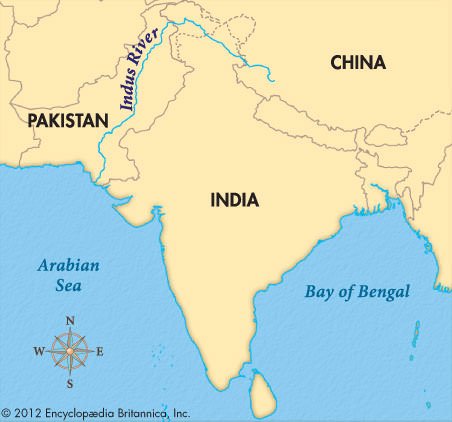
#2 ITS MOST IMPORTANT TRIBUTARY IS THE PANJNAD
The Indus begins in the Himalayan, Karakoram and Hindu Kush mountain ranges. It has several major tributaries. In Ladakh, its main left bank tributary is Zanskar. In the plains, its major left bank tributary is the Panjnad, a river at the extreme end of Bahawalpur district in the state of Punjab in Pakistan. The Panjnad is itself formed by successive merger of five rivers, namely Jhelum, Chenab, Ravi, Beas and Sutlej. The principal right bank tributaries of Indus in the plains are Shyok, Gilgit, Kabul, Gomal and Kurram. The northern part of the Indus Valley, with its tributaries, forms the Punjab region. Punjab is a historical region in South Asia which comprises areas of eastern Pakistan and northern India. The meaning of Punjab is the “land of five rivers”, referring to the five tributaries of Indus that form the Panjnad. The lower course of the Indus is a region known as Sindh. As the river flows into the Arabian sea, it forms the Indus River Delta, which covers an area of about 41,440 square km (16,000 square miles).
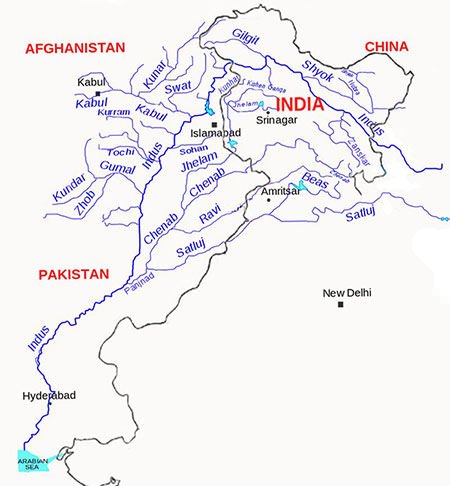
#3 ITS BASIN COVERS A MASSIVE AREA OF MORE THAN A MILLION SQUARE KMS
The total drainage area of the Indus is estimated to be 450,000 square miles (1,165,000 square km), one of the largest in the world. The trans-boundary Indus river basin is distributed between Pakistan (47%), India (39%), China (8%) and Afghanistan (6%). The Indus river basin stretches from the Himalayan mountains in the north to the dry alluvial plains of Sindh province in Pakistan in the south. In Pakistan, the Indus river basin covers around 520,000 km2. This is 65% of the territory of the nation including the whole of the provinces of Punjab and Khyber Pakhtunkhwa; and most of the territory of Sindh province and the eastern part of Balochistan. In India, the area covered by the Indus basin is 440,000 km2. This is nearly 14% of the total area of the country. The states of India in which the Indus basin lies are Jammu and Kashmir, Himachal Pradesh, Punjab, Rajasthan, Haryana and Chandigarh. The Indus basin accounts for just 1% of China’s territory while it covers 11% of the territory of Afghanistan. At least 300 million people are estimated to be living in the Indus basin

#4 INDIA IS NAMED AFTER THE RIVER INDUS
The River Indus was referred to as Sindhu in Ancient India. In Sanskrit, the language prevalent in Ancient India, the meaning of Sindhu is a “large body of water, sea, or ocean”. To the Persians the river was Hindu. From the Persian Achaemenid Empire, the name passed on to the Greeks as Indos and the Romans adopted it as Indus. The River Indus has different names in different languages of the region. Like in Hindi, the lingua franca of a major part of India, it is called Sindhu Nadi (River) while in Urdu, the official national language and lingua franca of Pakistan, it is called Daryā-e Sindh. The official name of the Republic of India was derived from the Sanskrit name ‘Sindhu’ that referred to Indus River. Moreover, the state of Sindh in Pakistan also gets its name from Indus.
#5 ONE OF THE GREATEST ANCIENT CIVILIZATIONS FLOURISHED ALONG INDUS
The Indus Valley Civilization (IVC), also known as Harappan Civilization after its first find-spot Harappa, was one of the four great ancient civilizations. It flourished in the basins of two major rivers: the Indus River; and Ghaggar-Hakra River, which is identified by many scholars as the dried up form of what was once the Sarasvati River. IVC encompassed most of Pakistan, a significant part of India and parts of Afghanistan. With an area around the size of Western Europe, it is the largest of the four ancient civilizations of Egypt, Mesopotamia, India and China. The era in which IVC existed is not known yet. According to a May 2016 study published in the prestigious Nature journal, experts now believe that the Harappan Civilization is 8,000 years old, 2,500 years older than previously thought. This would make IVC older than the Egyptian and Mesopotamian civilizations. Excavation of the sites of the Indus Valley Civilization is an on-going process and by 1999, 1,056 cities and settlements had been found.
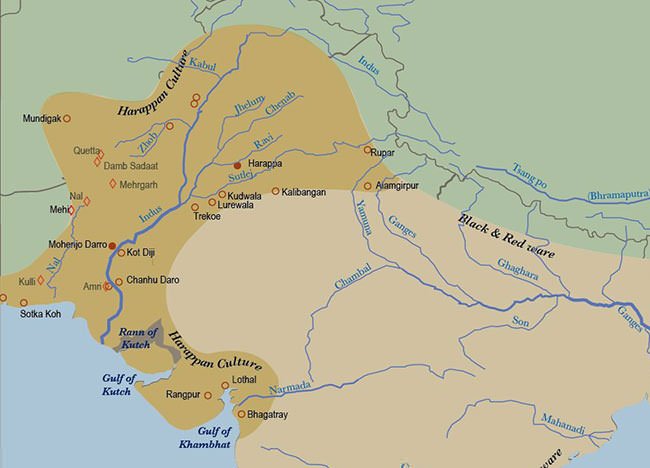
#6 IT PLAYS A VITAL ROLE IN THE ECONOMY OF PAKISTAN
According to Pakistan Water Gateway, the Indus River provides 80% of all the water consumed in Pakistan. It is key to the economy of the nation providing water resources for agriculture, industry, etc. The Punjab province, which is called the breadbasket of Pakistan and accounts for most of the nation’s agricultural production; as well as Sindh; lack a substantial amount of rainfall and are heavily dependent on Indus. Water from Indus helps irrigate about 45 million acres of land, which accounts for 80% of the total arable land in Pakistan. Indus is the source of water for many heavy industries in the nation thus supporting their operations and activities. Moreover, it provides the main supply of potable water in Pakistan. In addition to this, Indus is rich in fish due to which a large amount of fishing activity is carried out in the river. A modern fish harbor has been built near the port of Karachi, Pakistan. It helps store fishes for future sales and consumption. Prawns and fishes are exported to various nations as well as consumed in different parts of Pakistan.
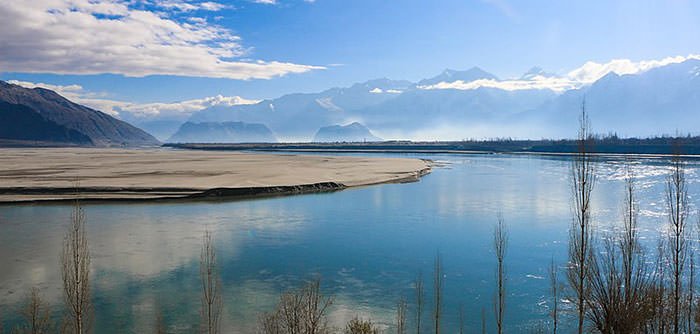
#7 INDUS WATER TREATY GOVERNS THE SHARING OF INDUS WATER AMONG INDIA AND PAKISTAN
There is a water-distribution treaty between India and Pakistan regarding sharing the water of River Indus and its five major Indian tributaries, Chenab, Jhelum, Beas, Ravi and Sutlej. The Indus Waters Treaty (IWT) was signed in Karachi on September 19, 1960 by the first Prime Minister of India Pandit Jawaharlal Nehru and then President of Pakistan Ayub Khan. According to the agreement, the control over the water of the three western rivers, Indus, Jhelum and Chenab, was given to Pakistan while that of the three eastern rivers, Ravi, Beas and Sutlej, was given to India. Brokered by the World Bank, the Indus Water Treaty is regarded as one of the most successful water sharing endeavors in the world today. India and Pakistan have not engaged in any water wars since the treaty was signed and all disputes have been settled via legal procedures, provided for within the framework of the treaty.

#8 THE INDUS RIVER DOLPHIN IS ONE OF THE WORLD’S RAREST MAMMALS
Indus is home to 25 amphibian species and 147 fish species, of which 22 are found nowhere else in the world. The best known variety of fish found in the Indus is hilsa and it is the most-important edible fish found in the river. Thatta, Kotri and Sukkur, all cities in the Pakistan province of Sindh, are important fishing centers. Platanista gangetica minor or the Indus River Dolphin is one of the rarest mammals on earth. Today it can only be found in the lower parts of the Indus River in Pakistan; and in River Beas, a tributary of the Indus River in Punjab, India.
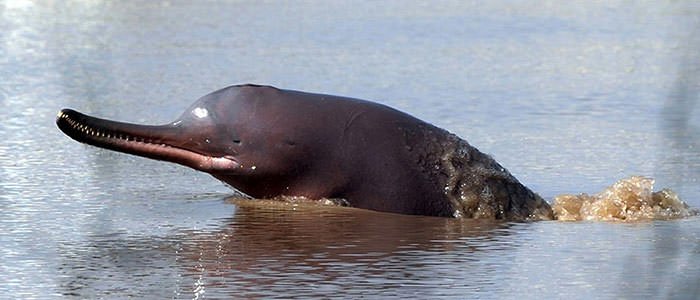
Punjab has, in fact, declared the blind but generally playful Indus River Dolphin as the State aquatic animal in February 2019. As their numbers are on a decline, the State Wildlife Department of Punjab plans to take further steps to safeguard this endangered species from disappearing in Punjab. The Indus Valley Delta, situated to the southeast of Karachi in Pakistan, is regarded as one of the most significant ecological areas in the world. It contains a wide variety of creatures, which include prawns and pomfret.
#9 REDUCING POLLUTION OF THE RIVER IS A MAJOR CHALLENGE FOR AUTHORITIES
River Indus is becoming polluted due to its overuse and sewage collection on its banks. The level of pollution is also rising due to setting up of heavy industries near the banks. Moreover, the use of water for the purpose of agriculture and irrigation has led to polluting the water from the toxic elements used in agriculture. Continuous disposal of industrial waste and sewage has also posed a threat to various species living in Indus, leading to continuous reduction in the number of endangered species in the river. These include the famous Indus river dolphin.
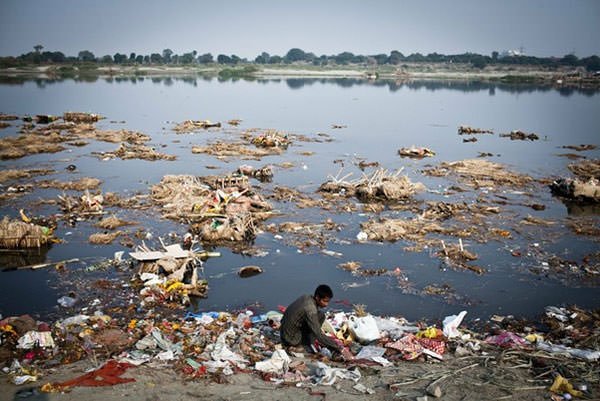
Apart from pollution, the Indus river dolphins are also dying as fishermen use poison to kill fish and scoop them up. Pakistani government has been taking initiatives to reduce the level of pollution in Indus. Among other things, the Sindh Environmental Protection Agency has ordered polluting factories around the river to shut down under the Pakistan Environmental Protection Act, 1997. However, these measures have largely failed to ensure that Indus is kept clean and pollution free.
#10 INDUS MAY BE SEVERELY AFFECTED DUE TO RISING TEMPERATURES
More than 70% of water in Indus comes from glaciers and high altitude wetlands. The Tibetan plateau has the third highest storage of ice in the world and temperatures there are rising four times faster than elsewhere else in China. This has led to the Tibetan glaciers retreating at a higher speed than in any other part of the world. This fast pace of melting glaciers will be good for agriculture and tourism in the short term. However, in the long term, it is predicted Indus could be severely “affected by glacier melt as a consequence of climate change”. Its flow could be reduced by as much as 50%. This, in turn, would have grave implications for the people who are dependent on the river. U.S. diplomat Richard Holbrooke, in fact, said that he believed falling water levels in the Indus River “could very well precipitate World War III.”

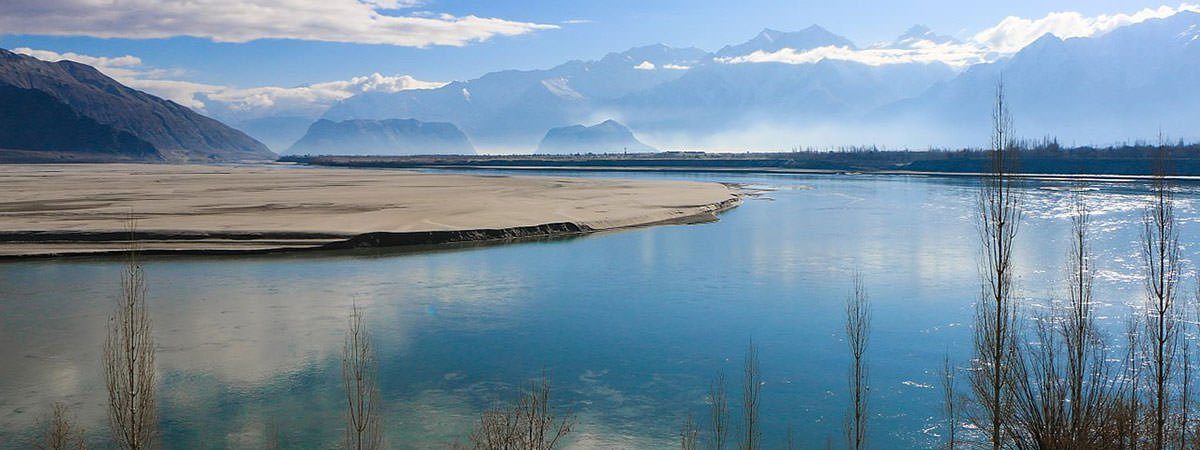
Its such as you read my thoughts. You appear to know so much about this, such as you wrote the book in it or something. I feel that you simply could do with some to power the message house a little bit, however instead of that, that is fantastic blog. An excellent read. I’ll definitely be back.